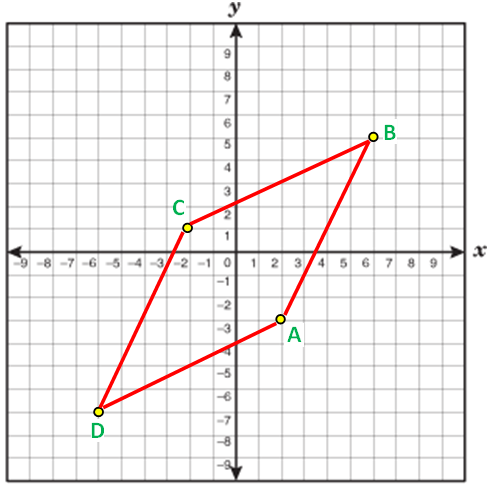HOW TO CHECK IF THE GIVEN FOUR POINTS FORM A RHOMBUS
(i) Find the length of all sides using the formula distance between two points.
(ii) In any square the length of diagonal will be equal, to prove the given shape is not square but a rhombus, we need to prove that length of diagonal are not equal.
Question 1 :
Examine whether the given points A (2,-3) and B (6,5) and C (-2,1) and D (-6,-7) forms a rhombus.

Solution :
Distance Between Two Points (x ₁, y₁) and (x₂ , y₂)
√(x₂ - x₁)² + (y₂ - y₁)²
Four points are A (2,-3) and B (6,5) and C (-2,1) and D (-6,-7)
Distance between the points A and B :
Here x₁ = 2, y₁ = -3, x₂ = 6 and y₂ = 5
= √(6-2)² + (5-(-3))²
= √(4)² + (5+3)²
= √16 + 8²
=
√16 + 64
= √80 units
Distance between the points B and C :
Here x₁ = 6, y₁ = 5, x₂ = -2 and y₂ = 1
= √(-2-6)² + (1-5)²
= √(-8)² + (-4)²
=
√64 + 16
= √80 units
Distance between the points C and D :
Here x₁ = -2, y₁ = 1, x₂ = -6 and y₂ = -7
= √(-6-(-2))² + (-7-1)²
= √(-6+2)² + (-8)²
=
√(-4)² + 64
= √16 + 64
= √80 units
Distance between the points D and A :
Here x₁ = -6, y₁ = -7, x₂ = 2 and y₂ = -3
= √(2-(-6))² + (-3-(-7))²
= √(2+6)² + (-3+7)²
= √8² + 4²
= √64 + 16
= √80 units
AB = √80 units
BC = √80 units
CD = √80 units
DA = √80 units
Length of diagonal AC :
Here x₁ = 2, y₁ = -3, x₂ = -2 and y₂ = 1
= √(-2-2)² + (1-(-3))²
= √(-4)² + (1+3)²
= √16 + 4²
=
√16 + 16
= √32 units
Length of diagonal BD :
Here x₁ = 6, y₁ = 5, x₂ = -6 and y₂ = -7
= √(-6-6)² + (-7-5)²
= √(-12)² + (-12)²
=
√144 + 144
= √288 units
Since the lengths of diagonals are not equal, the given vertices will form a rhombus.
Try other questions
(2) Examine whether the given points A (1,4) and B (5,1) and C (1,-2) and D (-3,1) forms a rhombus. Solution
(3) Examine whether the given points A (1,1) and B (2,1) and C (2,2) and D (1,2) forms a rhombus. Solution
Kindly mail your feedback to v4formath@gmail.com
We always appreciate your feedback.
©All rights reserved. onlinemath4all.com
Recent Articles
-
Digital SAT Math Problems and Solutions (Part - 150)
Apr 25, 25 11:46 AM
Digital SAT Math Problems and Solutions (Part - 150) -
AP Calculus AB Problems with Solutions (Part - 19)
Apr 24, 25 11:10 PM
AP Calculus AB Problems with Solutions (Part - 19) -
AP Calculus AB Problems with Solutions (Part - 18)
Apr 24, 25 11:06 PM
AP Calculus AB Problems with Solutions (Part - 18)
